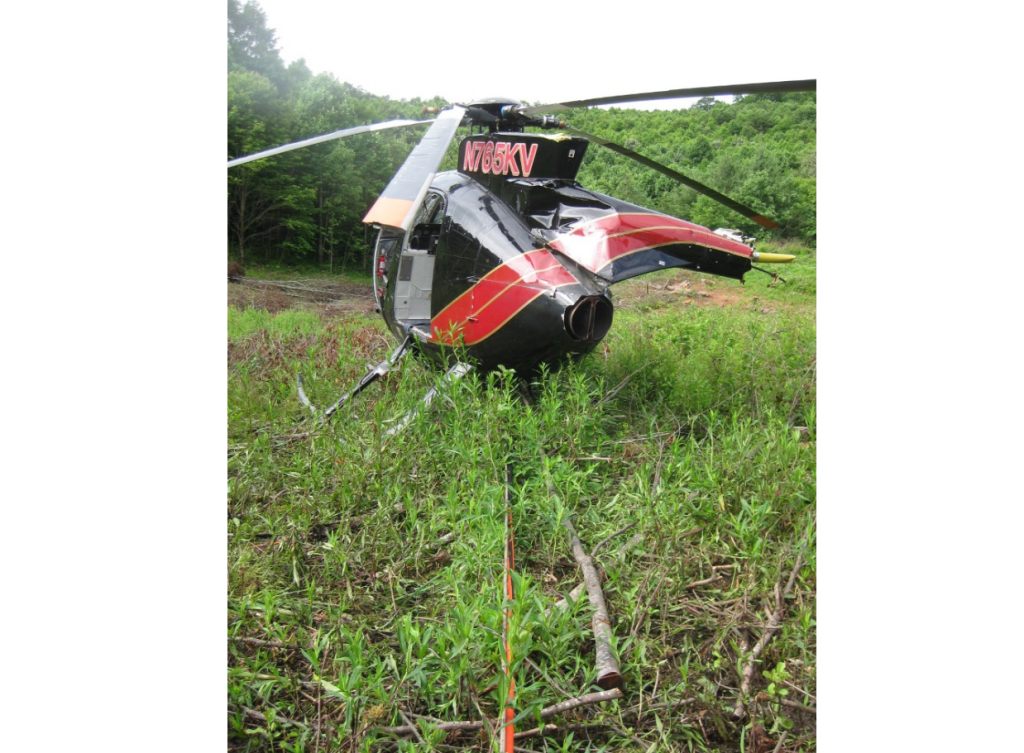HESLO Baffled Attitude Fuel Starvation Accident (Haverfield Aviation Hughes 369E N765KV)
On 23 June 2017 Hughes (later MD) 369E N765KV, being operated by Haverfield Aviation for a Part 133 long line external load flight, was substantially damaged after a power loss near Dennis, West Virginia. The pilot was uninjured.

Wreckage of Haverfield Aviation Hughes 369E N765KV after HESLO Fuel Exhaustion Accident (Credit: FAA via NTSB)
The Accident Flight
The US National Transportation Safety Board (NTSB) explain in their safety investigation report that:
The pilot reported that he returned to the landing zone with a conductor attached to a long line. …during the accident flight, the conductor was not completely off the ground and was being dragged over terrain. To compensate for the dragging resistance, the pilot had the helicopter in an aft or left attitude, with a higher nose-up attitude than normal flight.
The helicopter was in a 100-foot hover over the landing zone, while the pilot monitored a ground crewmember tasked to disconnect the conductor from the long line. The helicopter began to settle and the pilot raised the collective control; however, the helicopter continued to settle as a warning horn sounded and the engine noise ceased. The pilot then entered an autorotation and during the landing, a main rotor blade contacted the tailboom, which resulted in a tailboom separation.
The pilot…estimated that the loss of engine power occurred 45 seconds to 1 minute after transitioning from the pull to a hover.
Safety Investigation
Postaccident wreckage examination, which included a successful test-run of the engine, did not reveal evidence of any preimpact mechanical malfunctions or failures that would have precluded normal operation.
As is common with a Helicopter External Sling Load Operations (HESLO) flight the helicopter had been operating with a low fuel load.
…when the helicopter was positioned nose up with the remaining fuel onboard (about 7 gallons in each tank), the low fuel light illuminated. The two fuel tanks were connected by an interconnect passage, and each tank had an internal baffle.
The fuel pickup was located in the right front portion of the left fuel tank. Given that the low fuel light illuminated when the helicopter was positioned nose up, it is likely that the helicopter’s nose-up attitude during the long line operation led to the unporting of the remaining fuel, which resulted in fuel starvation.
NTSB Probable Cause
The unporting of fuel due to the helicopter’s nose-up attitude during long line operations, which resulted in fuel starvation and a total loss of engine power.
Operator Safety Action
The operator’s risk assessment form required that pilots land the helicopter with at least about 14.7 gallons of fuel remaining for long line operations. After the accident, the operator amended its risk assessment form to require the same fuel requirement as side pull operations (about 37 gallons of fuel remaining upon landing) for long line operations.
Safety Resources
- Survey Aircraft Fatal Accident: Fatigue, Fuel Mismanagement and Prior Concerns
- Running on Fumes: Fatal Canadian Helicopter Accident
- UH-1H Fuel Exhaustion Accident
- Load Lost Due to Misrigged Under Slung Load Control Cable
- Keep Your Eyes on the Hook! Underslung External Load Safety
- EC120 Underslung Load Accident 26 September 2013 – Report
- Unexpected Load: AS350B3 USL / External Cargo Accident in Norway
- Unexpected Load: B407 USL / External Cargo Accident in PNG
- Load Lost Due to Misrigged Under Slung Load Control Cable
- Fallacy of ‘Training Out’ Error: Japanese AS332L1 Dropped Load
- Helicopter External Sling Load Operation Occurrences in New Zealand
- Maintenance Issues in Fire-Fighting S-61A Accident
- Fuel System Maintenance Error: Tuniter ATR72 TS-LBB Ditching 6 August 2005
- Fuel Exhaustion Causes EMB-110 Emergency Landing
- NASCAR Driver and Pilot Died in Mooney M20C Fuel Starvation FOD Accident
- Canadian KA100 Fuel Exhaustion Accident
- UPDATE 25 September 2021: Fuel Starvation During Powerline HESLO (Haverfield Aviation Hughes 369D/500D N9159F)
- UPDATE 1 January 2022: Snagged Sling Line Pulled into Main Rotor During HESLO Shutdown
- UPDATE 18 March 2023: HESLO AS350 Fatal Accident Positioning with an Unloaded Long Line
- UPDATE 5 August 2023: A Concrete Case of Commercial Pressure: Fatal Swiss HESLO Accident


Recent Comments